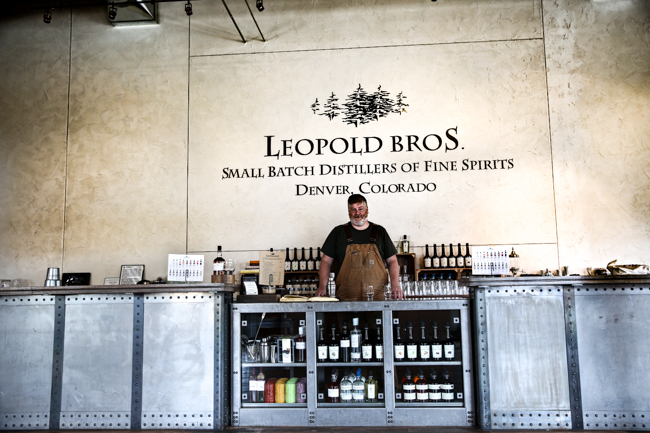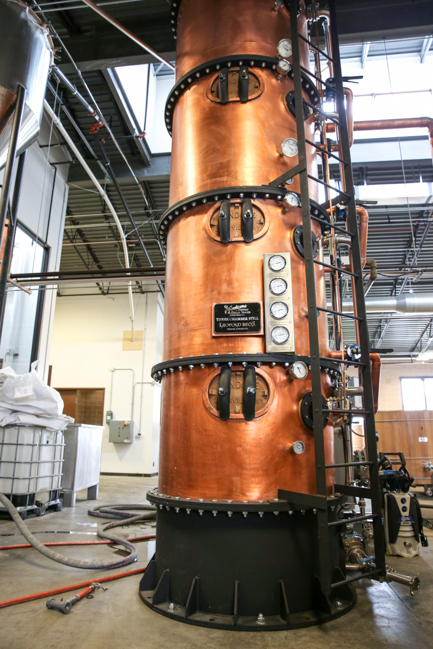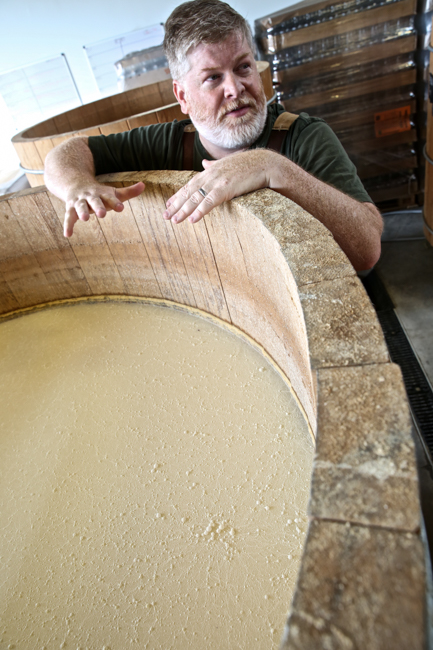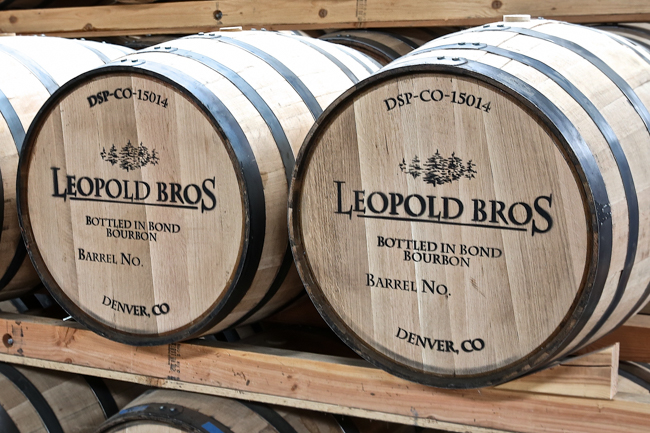Denver's Distillation Future

Meet Todd Leopold, co-owner and distiller of Leopold Bros distillery in Denver, Colorado. You may think you know him and his products, but I assure you: you do not. While you may be aware of his family's many achievements and the incredible portfolio of spirits they've produced over the last few years, I can promise you this: you have yet to really experience and appreciate just what Todd Leopold's family can do. Sure, his father is a landscape architect who helped decorate one of the most pristine campuses in the industry. Yes, his mother is a textile expert who put together the distillery's stunning interior piece by piece. Of course, his brother Scott (co-owner of the brand) trained as an environmental engineer at Stanford and constructed one of the greenest, most eco-friendly distilleries in the country. This information is common knowledge to the many people who think they know the Leopolds and their business. But what I learned this week is that the products that will ultimately come to define the Leopolds and their distillery have yet to be released. They're sitting in wood, racked in a dunnage style warehouse immediately next to the production facility. They are magnificent spirits, steeped in flavor, tradition, and an incredible amount of historical accuracy—painstakingly researched with a level of sophistication usually reserved only for savants. What we think we know of the Leopolds is founded in the present. We know their current work quite well at this point. What we will come to know them for, however, has yet to be unveiled.

The Leopolds have moved around a great deal in their lives. Their father worked for the government when they were kids and was forced to relocate frequently, rendering the two brothers almost defacto best friends. Their work together has also migrated; the current incarnation of the Leopold Bros distillery is the third of its kind. The first was located in Ann Arbor, Michigan. The second was also in Denver, just a few blocks down the road. The latest facility (and hopefully final) has only been operational for about two years now, meaning the whiskey currently being made has yet to hit the market. That’s an important point to consider when evaluating their previous work because the strides they’ve taken since then are unparalleled in the American whiskey scene. Leopold Bros does everything from scratch. 100% of the grains used are floor malted by hand, meaning rye, wheat, and barley. With the exception of their grape-based absinthe and maraska cherry liqueur, all of their base spirits are made in house. Even their silky Silver Tree vodka starts off as a fermented barley, wheat, and potato mash in a Vendome pot still before finishing its distillation on the column. While you may have guessed chemistry, Todd Leopold’s background is actually in malting. From 1995 to 2008, he made beer for a living. He has studied and worked in Germany as well, including a stint at Würzberger Hofbräu, perfecting a number of hefeweizen and pilsner recipes before moving over to distillation. In fact, he's so good at malting that a number of breweries are now coming to him for their base malt. As he if he wasn't busy enough, contract malting has now become a side business for the company.

Properly malting one’s grains also involves drying them in a kiln. Just like at Port Ellen and many of the beloved Japanese distilleries, Leopold is adorned with a romantic pagoda roof through which the warm air is released during that finishing process. While Todd does make single malt whisky, he uses a fan rather than peat smoke as as a heat source because once that smoky, peaty, campfire aroma gets in, there's no getting it out. Seeing that the grains for all his whiskies must pass through the kiln, peat is strictly forbidden. I was curious as to why exactly Todd preferred old fashioned floor malting to the more modern and efficient practices maltsers have developed over the years. Was it just for rusticity's sake, or was there indeed a better flavor that came from more antiquated methods? “A floor malt has its own unique environment," he said to me; "It's cooler than a malting house and it's inconsistent, which is the point." Apparently the malting temperature can vary by two or three degrees throughout the floor, meaning different kernels malt to different levels. "It's inconsistent, but it's not imprecise; I'm monitoring it so there's just enough difference to add depth of flavor," he added. Those small differences create a variance that ultimately adds richness and complexity of flavor in the final spirit. "It's more hands on," he continued, "and a combination of technical science with hands on experience is important when making whiskey.”

The other thing to keep in mind about Leopold Bros is that it isn't all that small of an operation. There are eight different stills operating and about a dozen wooden fermenters, making a number of different spirits at any given time. The variety of different shapes, sizes, and pots allows Todd complete versatility at a level I've never seen at any facility ever. A distillation run might begin on one still, then receive it’s second distillation on a completely different machine, depending on which flavors he's looking for in that particular batch. Believe me—he's constantly geeking out about this stuff. I would explain it to you but it involves a lot of talk about esters, acids, and various chemical compounds. I understand it in theory, but I’ll leave it at that.

Let's talk about this guy now: the big secret that everyone's dying to know more about, from whiskey historians like David Wondrich and Mike Veach, to whiskey super nerds who masterbate over production details and spec sheets. This girthy piece of equipment is called a chamber still and it was once used in a number of American distilleries around the turn of the 20th century and into the mid-1900s. Few people, however, seem to understand exactly how or why it was used. Fortunately for us, Todd is a dedicated researcher and reader of old documents. He spends his free time digging out the recorded minutes from forgotten community farmer meetings, or various malting essays written by brewers in the 1920s. Even Vendome, the heralded American still company that made the equipment for him, doesn't really understand how the chamber still works—and that's exactly how Todd likes it. This is his baby—his reenactment—and he thinks its going to set Leopold Bros apart from the general market in a major way. Working from a design he located in an old diagram of Hiram Walker's former plant in Peoria, Illinois back in 1910, Todd helped to create this three column monster that—despite its look—distills in batches rather than continuously. I don't want to give away too many of Todd's secrets, but lets just say that there is mash loaded into each level and as the liquid vaporizes it passes through the mash as it moves up through the chamber. Think of gin vapor moving through a botanical basket, but instead it's actual whiskey vapor moving the same flavorful whiskey mash from which it was originally boiled. Todd has been distilling rye on this beast for the last six months and the result is pretty ungodly. We're still many years away from a release to market, but expect heads to explode once Todd finally decides to share it. The resulting spirit is far more flavorful and oily than any rye whiskey I've ever tasted. I can't even imagine what it will taste like after four years in wood.

Fermentation technique also sets Leopold Bros apart from many of its colleagues. Todd chooses to ferment his whiskey mash at a much cooler temperature than most Kentucky distilleries, for example. He also lets it go for more than 120 hours which is longer than I've heard of for any whiskey producer. The result is a fruity and complex liquid that has more inherent flavor than just about any whiskey beer I've sampled in my distillery visiting days. It’s slow and low, baby; just like Texas barbecue! Then take into account the other factors that Todd is utilizing like the fact that he's purposely planted fruit trees outside the distillery wall so that, when the windows are opened, the wild and native yeasts from the fruit make their way into the building, embedding themselves in the wooden fermentation tanks. At this point there's so much organic matter playing an active role in Todd's mash that it actually forms a layer of bacteriological flor! I've never even heard of that happening at a whiskey distillery, but apparently it's common in the brewing of sour beers with all that lambic action.

Regardless of what the Leopolds are doing now, it’s what they’ve already created and sold that customers know them by. Two world class gins made by distilling each botanical separately into its own spirit, then blending those resulting spirits into two completely different small batch products. A ridiculously vast and delicious portfolio of liqueurs including three fruit-macerated whiskies that taste like heaven. A Campari-like aperitivo. A pristine vodka and, of course, a small batch American whiskey. However, it’s what’s sitting here in barrel that I believe will some day elevate Leopold Bros from a devoted boutique distillery into the upper echelon of serious American whiskey culture. It’s inside the dunnage warehouse—an exposed floor building with no electricity and all natural lighting—where the temperatures fluctuate greatly between the hot Colorado summers and frigid Denver winters, creating the perfect environment for whiskey maturation. It’s there that you’ll find Leopold Bros single malt, Tennessee style whiskey, Maryland style rye whiskey, Bottled in Bond Bourbon, and the coveted Leopold chamber rye still whiskey still in its infancy. All five whiskies are beyond anything Leopold has brought to the general market thus far, and—with the exception of the Maryland rye—four of them have never been released whatsoever. But it’s not just the fact that Todd Leopold is making Bourbon, or Tennessee whiskey, or chamber still rye that has me excited. It’s that Todd Leopold is going back into historical manuals, doing his homework, researching even the filling proofs of these former whiskey styles, and incorporating a number of traditional and overlooked techniques long forgotten by the current generation of distillers in order to do so.

From the particular strain of the barley and rye, to the hands on specifics of floor malting, to the kilning and the milling of the grain, to the cultivation of yeast, to the time and temperature of fermentation, to the type of still, to the charring of the barrel, to the natural conditions of the warehouse, Todd Leopold has geeked out about the minute details of whiskey production to a level perhaps unseen in this business. He’s not only the co-owner of his company; he’s the bonafide expert of every single process of its production from front to back. In the process, he’s become a beacon of American distillation knowledge; a veritable sponge of semantics. But does that maniacal level of dedication make the whiskey taste better, you ask? I don’t want to ruin the ending of such a great story so far in advance, but you’ll know in a few more years—right about the time the Leopold brothers take over the world. What you should be most excited about is this: everything that American farmers, maltsters, brewers, and distillers have discarded and removed from whiskey production over the last century in the name of efficiency and economics has been painstakingly researched, rediscovered, and reinserted back into the process by Todd Leopold. Come bottling time circa 2019, you’re all going to find out exactly what you’ve been missing. You’re going to find out a lot more about the Leopolds and their incredible spirits than you thought you knew.
-David Driscoll
